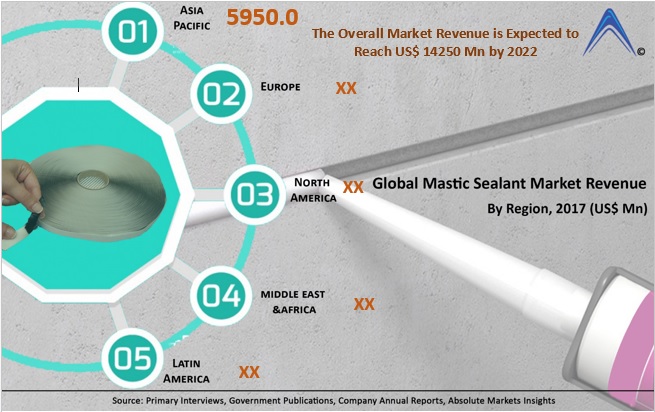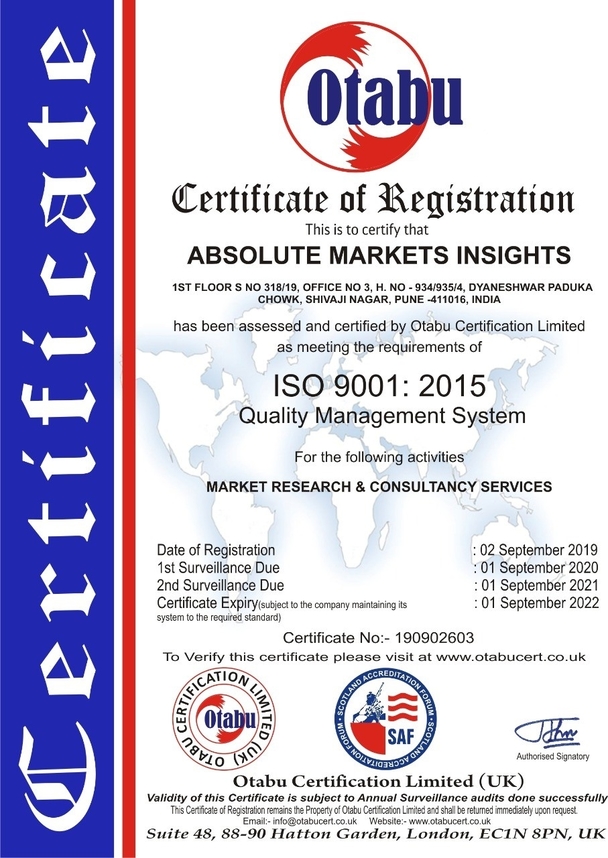
Global Mastic Sealant Market Estimated to Reach US$ 14250.0 Mn by 2022, Due to Growth of Polyurethane Sealants for Construction Activity in Developing Countries
Absolute Markets Insights offers its latest published report 'Mastic Sealant Market by Material (Silicone, Polyurethane, Acrylic, Polysulfide, Epoxy and Others); by Sector (Construction, Industrial, Transportation, Appliances, Aerospace and Others); by Regional outlook (U.S., Rest of North America, France, UK, Germany, Spain, Italy, Rest of Europe, China, Japan, India, Southeast Asia, Rest of Asia Pacific, GCC Countries, Southern Africa, Rest of MEA, Brazil, Rest of Latin America) – Global Insights, Growth, Size, Comparative Analysis, Trends and Forecast, 2018 - 2026’. The author of the report analyzed that the Global Mastic Sealant Market accounted for US$ 10790.0 Mn in 2017. Rise in demand for mastic sealant in various applications, such as pressure sensitive, construction, furniture, and automotive, is estimated to drive the market during the forecast period 2018 – 2026.
Purchase the complete report titled “Mastic Sealant Market - Global Insights, Growth, Size, Comparative Analysis, Trends and Forecast, 2018-2026” at https://www.absolutemarketsinsights.com/reports/Global-Mastic-Sealant-Market-2018-2026-9

Steady growth in construction activities, are driven by increased urbanization and infrastructure improvements in developing countries such as India and China. Along with this, the increased construction spending in Western Europe and the U.S. is driving the mastic sealant market.
Due to its thickness, it is best applied to thick rather than thinner areas of application, such as large gaps and cracks. This gap width restricts the deployment of mastic sealant in various applications. Manufacturers are focusing on developing mastic sealants that are compatible with felt & asphalt making them ideal for industrial and commercial roofing repair work, sealing and bonding leadwork and any other types of waterproof joint work on roofs, around chimneys, fascia, facades and more. The development of a wide array of applications presents tremendous growth opportunities for the mastic sealant market.
Construction Anticipated to be the Dominant Segment during the Forecast Period, 2018-2026
Construction accounted for the largest and most attractive market for mastic sealants. Countries such as China, India, Indonesia, Saudi Arabia and UAE have seen an increase in investments as well as government sanctions to develop residential and commercial structures.
Rapid Industrialization and Urbanization to Drive the Market in Asia-Pacific
The rapid industrialization and urbanization in countries such as China and India have resulted in the expansion of various end-user industries such as automotive, construction (residential, and nonresidential) driving the demand for mastic sealant. Besides, the improvements in road and infrastructure maintenance activities in this region are also driving the demand for mastic sealant.
Mastic Sealant Market is Fragmented with the Presence of Global and Regional Players
Some of the prominent participants in mastic sealant market are 3M Company, ND Industries, Inc., H.B. Fuller, Carlisle Fluid Technologies, Bostik Philippines Inc., Eastman chemical Company, Wacker Chemie AG, ADCO Global, Inc., Sika AG, Momentive Chemical Specialty Chemicals Inc., amongst others. In January 2017, H.B. Fuller announced the purchase of industrial adhesive business of Wisdom Worldwide Adhesives based in Illinois, the U.S. extending its presence in this region.
Mastic Sealant Market – By Material Type
- Silicone
- Polyurethane
- Acrylic
- Polysulfide
- Epoxy
- Others
Market By Sector
- Construction
- Industrial
- Transportation
- Appliances
- Aerospace
- Others
Mastic Sealant Market – By Region
- North America
- U.S.
- Rest of North America
- Europe
- France
- The UK
- Spain
- Germany
- Italy
- Rest of Europe
- Asia Pacific
- China
- Japan
- India
- Southeast Asia
- Rest of Asia Pacific
- Middle East and Africa
- GCC Countries
- Southern Africa
- Rest of Middle East and Africa
- Latin America
- Brazil
- Rest of Latin America

